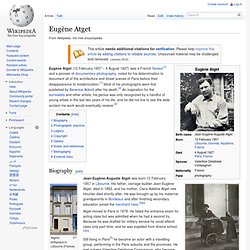

A Word with Eugène Atget. Cover of the publication Atget.

John Szarkowski. 2000. The Museum of Modern Art, New York In concert with the current photography exhibition Eugène Atget: “Documents pour artistes”, MoMA has republished Atget, a richly illustrated title first published by the Museum in 2000. A series of brief texts by author John Szarkowski accompanies each of the 100 photographs in the book, ranging from musings on the art and craft of photography, to explications of French culture and history, to insight into the unique character of Atget’s legacy. Szarkowski, who was Director of the Department of Photography at The Museum Modern Art from 1962 until 1991, was also an accomplished photographer. Reading the book for the first time, I was struck by the consonance between Atget’s images and Szarkowski’s writing.
Eugene Atget at MOMA: A review of "Documents Pour Artistes" "St.

Cloud," Eugene Atget, All rights reserved From 1898 to 1927 a modest handmade sign, “Documents pour Artistes,” hung outside Eugene Atget’s small one-room studio in Paris. In those days passersby would have read the sign without irony, but now it has become the title of a major show of Atget’s photographs at the Museum of Modern Art (MOMA). Would Atget appreciate the joke? He made his living systematically photographing the old quarters of Paris on spec, then selling his “documents ” as mounted prints. More than a century later Atget’s pictures evoke a very different response. "Mannequins," Eugene Atget, All rights reserved If we go by the testimony of the photographers who came after Atget, that’s certainly accurate. I go on about this because such “ugly duckling” stories – with their eventual transformations into artistic swans -- happen rarely. "Marchand abat-jours," Eugene Atget, All rights reserved "Jardins de Luxembourg," Eugene Atget, All rights reserved.
Masters of Photography - Eugéne Atget Lens culture photographer interview: Christopher Rauschenberg on Rephotographing Atget. The unintentional Surrealism of Eugène Atget. Eugène Atget, Church of St Gervais, Paris, about 1903, albumen print from gelatin dry plate negative.

Museum no. Ph.224-1903, © Victoria and Albert Museum, London Eugène Atget (1857–1927) took up professional photography in the late 1880s. Details of his earlier life are shadowy. He is known to have been a sailor and then an amateur actor, which may account for the 'stage set' quality of many of his images. His project to record 'Old Paris' began around 1897 and continued until the 1920s. Today, however, Atget is admired less as a record photographer and more as a forerunner of Surrealism and of modern approaches to the art of photography.
This shift in perception about Atget's work began in the last years of his life, when he met Berenice Abbott, a young American working in Paris for the photographer Man Ray. This text was originally written to accompany the exhibition Eugène Atget: Unintentional Surrealist? Tip: Drag the grid or click the button in the corner to reveal more images. Atget Photography.com.
Atget. Eugène Atget. Organ Grinder (1898) Eugène Atget (12 February 1857 – 4 August 1927) was a French flaneur[1] and a pioneer of documentary photography, noted for his determination to document all of the architecture and street scenes of Paris before their disappearance to modernization.[1] Most of his photographs were first published by Berenice Abbott after his death.[2] An inspiration for the surrealists and other artists, his genius was only recognized by a handful of young artists in the last two years of his life, and he did not live to see the wide acclaim his work would eventually receive.[2] Biography[edit] Atget's birthplace in Libourne (France) Jean-Eugène-Auguste Atget was born 12 February 1857 in Libourne.

His father, carriage builder Jean-Eugène Atget, died in 1862, and his mother, Clara-Adeline Atget née Hourlier died shortly after. Atget moved to Paris in 1878. Still living in Paris[5] he became an actor with a travelling group, performing in the Paris suburbs and the provinces. Legacy[edit]